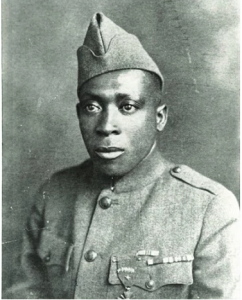Henry Johnson
During my summer Internship at the National WWI Museum and Memorial, our primary focus as Interns has been to rework lesson plans about World War I so they are ready to be used as teacher resources. I have learned that this is an in-depth process. While working on lesson plans, I found myself googling and regoogling things such as copyright laws and how they apply to everything from old newspapers to images. I became familiar with the Museum and Memorials collection of propaganda posters like they were my old friends. Some lesson plans needed only a couple citations fixed, others needed complete reformatting and writing.
It was the subject matter in these lesson plans that not only kept me searching for the missing information, but would captivate me with what I would find. The lesson plan that I enjoyed working on the most was about war hero Henry Johnson and the battles he faced coming home from the service. Henry Johnson was a soldier from the African American division called the “Harlem Hellrattlers” in World War 1. One day him and his buddy Needham Roberts were on watch duty when a surprise attack of twelve German soldiers appeared. Henry and Needham’s guns jammed and so they had to fight off the twelve soldiers using only knives. In the lesson plan, students are told to examine newspaper articles from the time and look at how the media presented Henry Johnson when he arrived home in 1919. They are told to compare accounts from before and after Henry Johnson gave his controversial lectures to the public. Looking at how these lectures affected the public’s opinion of him. While researching it, I found Military Intelligence reports on Johnson detailing how he was dangerous because he was said things that were not “patriotic” the government; a government that had segregated him even in the military. This is example of one perspective of him that students would look be told to analyze.
Lesson plans like this work to help students understand how and why we are where we are today. Because of this I felt excited to play my part in helping this story come alive to students through the primary source documents I carefully collected.
photo courtesy of wikicommons.

